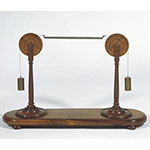The apparatus resembles a model first described by Willem Jacob 's Gravesande in Physices elementa mathematica, experimentis confirmata (3rd ed., Leiden, 1742). Its purpose is to demonstrate the conditions for placing a suspended lever in equilibrium.
A wooden base carries two turned pedestals, each holding a pillar with a pulley at its top. Over each pulley passes a cord carrying a counterweight at one end and fixed to either end of an iron bar on which are engraved 15 evenly spaced notches. The bar is suspended in horizontal equilibrium. If a weight W is applied to the center of the bar, the equilibrium will be maintained by adding two weights of W/2 each to the existing counterweights. If W is applied not at the center but at a point dividing the bar into two unequal segments, the added weights must be inversely proportional to the lengths of the corresponding segments of the bar in order to preserve the equilibrium. Provenance: Lorraine collections.










